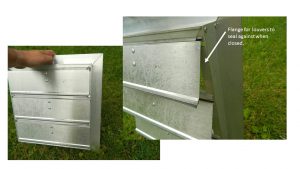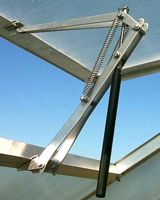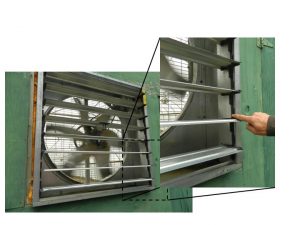I have received many inquiries about how to improve ventilation of high tunnels from growers with tunnels that have only roll-up sides. The issues they are facing tend to be either high temp, high humidity or both, leading to plant stress or disease. These situations tend to be in less than ideal sites for ventilation and/or temperature control. For example, crowded lots with trees or other significant wind breaks close to the tunnel, high southern exposure (which can be good of course), and/or simply calm sites that provide little ventilation.

Roll-up sides alone tend to work for tunnels on sites with generally good air flow. Diffusion between inside and outside does happen, of course, but is slow and unlikely to achieve good ventilation along the center of the tunnel, especially with dense vegetation later in plant maturity. But, I think of a tunnel in this instance a bit like a wood stove. Without a chimney-effect natural draft, you’re really only getting ventilation from the sides and only then if there is a decent breeze. Warmer air and, therefore, humidity will tend to collect in the canopy and peak.

This probably is OK in many sites for most crops. But not always. In many cases gable vents will improve ventilation by acting as outlets for warm humid air in warmer seasons and by allowing for low volume ventilation in colder weather. I recommend a simple 24″x24″ gable vent (for a 30’x96′ tunnel) on each end wall, with a thermostatic wax cylinder actuator like the ones made by J. Orbesen Teknik APS available from LittleGreenhouse.com., FarmTek, and Agricultural Solutions among others The actuators require no electricity, are relatively inexpensive and are passively controlled by the wax cylinder based on temperature.
At the very least, when building end-walls consider framing in a rough opening to accept a 24″x24″ in the end wall so that a future install is easier. If you want to skip the expense of a louvered, wax cylinder system, you can use a manually-controlled sheet of plywood to open and close the vent. If you go with a louvered vent, seek one that has a flanged seal it closes against. Keenan Meier, and Munters-Euroemme has such flanged, louvered dampers.

These have zero daylight when closed which results in a solid seal. Most others on the market that I have seen have no such closure seal.
Fans
Fans in greenhouses and high tunnels generally perform two tasks: (1) circulation / mixing / stirring and (2) ventilation.
- Circulation / Mixing / Stirring – Sometimes referred to as horizontal air flow or “HAF” fans, these fans are generally hung from the inside horizontal structural tubing. They only mix the air. The benefit of this is consistent, well distributed growing conditions. It also ensures that your control sensors are seeing the “average” conditions of the space. Remember that HAF fans work to mix the space (circulate the air) but don’t significantly improve ventilation. HAF combined with roll up sides can do the trick, but the site is the key. There needs to be a steady cross breeze for any significant air exchange to occur.
- Ventilation – Ventilation, or “exhaust” fans provide air exchange between the inside and outside. This is really important in controlling temperature (cooling) or humidity (drying). The only way to remove heat or humidity from a standard high tunnel or greenhouse is by actively removing air from the space and bringing in outside air. Ventilation (cooling) systems are covered very well by Bartok and Aldrich (p. 70). Basic rules of thumb for ventilation are 8 CFM/ft2 (of growing space) for summer cooling and 2 CFM/ft2 for cooler months.
References: